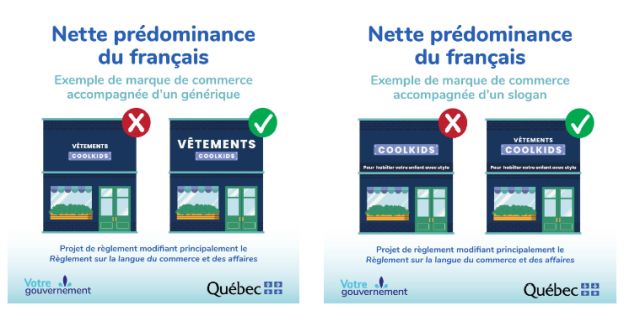This article is part of our series on recent amendments to the Charter of the French Language under Bill 96. Click here to read Part 1: Inscriptions on Products.
Following the adoption by the Quebec National Assembly of Bill 96 in June 2022, which overhauled and strengthened French language requirements under the Charter of the French language in the province of Quebec (the "Charter"), both practitioners and businesses carrying on activities in the province have been waiting for an updated Regulation regarding the language and commerce of business. The much-anticipated draft regulation (the "Regulation") was finally published on January 10, 2024, shedding light on certain areas of doubt raised by Bill 96, while also raising some additional questions.1
Below is a summary of the key proposed changes regarding public signage and commercial advertising. We invite you to also consult our additional articles on Inscriptions on products, as well as on the language of contracts.
General Rule
Even before Bill 96, public signs and posters that are both in French and another language were required to feature the French text in a "markedly predominant" manner, which was defined by regulation.
Exception for trademarks in a language other than French
Trademarks "recognized" under Canadian trademarks law could (and still can until June 1, 2025) appear only in a language other than French, as long as the French version of such trademark was not registered in Canada. Bill 96 introduced in respect of public signage essentially the same limitation as it did for product inscriptions (please refer to Long-Awaited Regulation Clarifies Bill 96...or Does It? – Part 1: Inscriptions on products), and only trademarks registered in Canada will be able to appear only in a language other than French on public signage. However, the Regulation does not provide in respect of public signage requirements the same transitory relief provided for inscriptions on products; trademarks for which an application is pending will not be considered to be registered, and there is not grace period allowing trademark owners more time to transition to new signage.
This is unfortunate given that the delays to obtain registration of a trademark in Canada are as relevant to public signage as they are to product inscriptions, and the delays required to change public signage can also be important (given the work required, permitting, etc.).
Greater visual impact of French
Since 2016, trademarks benefiting for the exception above were also required to be accompanied by a "sufficient presence" of French. The requirement for a "sufficient presence" of French is now replaced by the requirement that the French be markedly predominant, which is achieved if the French has a "much greater visual impact" than the text in another language.
Text will be considered to have a "much greater visual impact" where, within the same visual field (a term referring to an overall view where all components of the public signage are visible and legible at the same time without having to move), the French text is at least twice as large as the text in another language and the French text's legibility and permanent visibility are equivalent to those of the text in another language. Based on the below published by the Government of Quebec, this would be non-limitative, as under the first acceptable example each portion of French text is not twice as large, but there is overall more French verbal matter than non-French verbal matter:

(Source: Government of Quebec)
Public signs and posters will be considered to meet the requirements for legibility and visibility where they are designed, lighted, and situated to be, at all times, simultaneously easy to read. To be considered permanent, public signage must not be likely to be easily removed or torn off.
In assessing the marked predominance of French, business hours, phone numbers, addresses, numbers, percentages and definite, indefinite or partitive articles are not taken into consideration. Any elements which are specifically carved out under an exception under the Charter (such as family names or non-French trademarks other than those which not appear on public signage visible from outside premises), are also excluded from the assessment of visual impact.
In the spirit of maintaining the marked predominance of French, trademarks or enterprise names appearing in another language on public signage visible from outside premises must be accompanied at least by some French text, whether it takes the form of generic text, a description of the product, or a slogan. This is a significant departure from the existing requirement, where in addition to the foregoing any other term or indication, favouring the display of information pertaining to the products or services to the benefit of consumers or persons frequenting the site could for the basis for the sufficient presence of French. Moreover, based on the examples below published by the Quebec Government, in order to achieve the "greater visual impact", the only way to have the trademark maintain a prominent size is to have more than one generic, description of slogan, and if there is only one, it has to be twice the size of the trademark.

(Source: Government of Quebec)
The Regulation also provides that a public sign or poster is considered to be "visible from outside premises" where they may be seen:
- From outside an open or closed space, including an immovable, a group of immovables, and a shopping centre; or
- On a bollard or other independent structure, including a pylon sign, unless more than two trademarks or enterprises appear on the pylon sign.
Commercial Advertising
French language requirements regarding commercial advertising (a category which spans catalogs, brochures, leaflets, commercial directories, purchase orders and any other similar document available to the public) was left largely unscathed by Bill 96, with its changes only confirming how the existing provision had been interpreted in the past.
The Regulation confirms current interpretation and enforcement practice, in that the content published on websites or posted on social media is explicitly identified as falling within the scope of the commercial advertising requirements; the French versions of websites and social media posts must therefore be available to the public under conditions that are at least as favorable as the version in a language other than French.
Interestingly, commercial advertising is the only category for which the trademark exception remains untouched.
How Can We Help?
As the regulatory landscape continues to evolve, non-compliant behavior is simultaneously being confronted with increasing scrutiny by the Office québécois de la langue française. As the Regulation fully enters into force on June 1, 2025, enterprises carrying on activities in Quebec should use the year and a half ahead to assess their risks accordingly and proactively address any gaps between existing practices and obligations under the law.
Footnote
1.Please note that the Regulation is currently in the 45-day public consultation period during which comments on the proposed changes may be submitted to the Minister of the French Language. The final version of the Regulation may therefore differ from the changes summarized here.
To view the original article click here.
The content of this article is intended to provide a general guide to the subject matter. Specialist advice should be sought about your specific circumstances.



